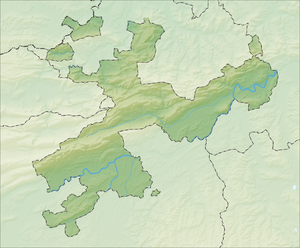Balm ruin
| Balm ruin | ||
|---|---|---|
|
Ruin of the Grottenburg Balm |
||
| Creation time : | Middle of the 11th century | |
| Castle type : | Höhenburg, grotto castle | |
| Conservation status: | ruin | |
| Place: | Balm near Günsberg | |
| Geographical location | 47 ° 15 '20 " N , 7 ° 33' 18" E | |
|
|
||
The Balm ruins are the ruins of a hilltop castle in the Solothurn community of Balm near Günsberg at the foot of the Balmfluh. It is the only cave castle in the canton and one of the few in Switzerland. Balm was originally written »Balb« and is Celto-Roman and means roughly: overhanging rock.
investment
The castle was built in a natural cave around 20 meters wide and 6 meters deep in the Jura at a height of 20 meters .
The 2.4 meter thick outer wall was provided with two door openings and narrow windows. A lining wall protected the wet rock face , the rest was a simple two-storey wooden construction, as beam holes show. The wall openings visible today have been falsified by the restoration. In a later construction phase, an inhabited fortified house 29 meters long with an interior width of 3.5 meters was built on the forecourt. A mighty wall square leaning back against the rock face has been preserved. It was probably a defensive wall surrounding an agricultural building complex.
Access to the main castle was via an elongated, partly masonry, partly carved staircase via a rock ramp. The connection between the outer and core of the castle can only be partially reconstructed. Today's climb is of modern origin and only partially corresponds to the original.
Excavations from 1939 and 1941 indicate that the site has been used as a settlement site since Azilia .
history
Experts estimate that the castle complex was built in the middle of the 11th century. This would make it one of the oldest castle complexes in the canton of Solothurn. The oldest surviving documentary mention of the castle comes from the year 1201. The alleged builders were the noble lords of Balm , who are first mentioned in the Flumenthal year book (probably 12th century) with Fridericus von der Hüli and his son Guntram. Burkart von Balm is documented around 1200. The Balm Castle forms the center of a small clearing lordship, which was only more clearly defined in the late Middle Ages and which is roughly identical to the later municipal ban on Balm.
The Lords of Balm moved out of their ancestral castle relatively early to move into a new castle in Altbüron . The old cave castle was given to a fiefdom holder. As a result, it escaped destruction by Duke Leopold, who destroyed the ancestral seat of the Barons von Balm in Altbüron in 1308 because Rudolf II von Balm was involved in the murder of King Albrecht near Windisch . As a result, the rule came to the empire and passed to the Count of Strassberg , who in turn pledged it in 1320 to the Solothurn knight Pantaleon von Gebstrasse.
In 1327 the lordship and castle came into the possession of Count Rudolf von Neuenburg-Nidau . He fell in the fight against the Gugler, his heirs sold the castle in 1374 to the Peter Schriber merchant family from Solothurn , which meant that the castle's actual feudal period was over. Schriber's heir, Arnold Bumann, sold the castle to the city of Solothurn in 1411, which enabled it to expand its sphere of influence considerably. As early as 1400, the castle was in a neglected condition. Around 1417, Solothurn lent Balm Castle to a Hans Sigrist from Naters in return for annual interest. It demanded a thorough structural repair, an obligation that Sigrist did not or hardly fulfilled. Although the archaeological finds show that the castle was occupied until around 1450, no major repairs seem to have been carried out. The castle has been in ruins since the middle of the 15th century, and at times it was used as a quarry by farmers.
In 1939 the ruins were acquired by the Historical Association of the Canton of Solothurn. Between 1939 and 1941 he arranged a thorough excavation and the securing of the ruins. The association ceded the ruins to the canton of Solothurn in 1969. At the same time, the Balm Castle Association was founded, which looks after the ruins.
literature
- Werner Meyer : Castles from A to Z - Burgenlexikon der Regio . Published by the Castle Friends of both Basels on the occasion of their 50th anniversary. Klingental printing works, Basel 1981, pp. 192–194.
- Fritz Hauswirth: The most beautiful castles and palaces in Switzerland . Neptun, Kreuzlingen 1977, ISBN 3-85820-024-7 , pp. 240-242.
- Bruno Amiet : The castles and palaces of the Canton of Solothurn. Basel 1930. (The castles and palaces of Switzerland, Vol. III)
- Emil Erdin: Castles of Switzerland, Volume 7. Silva-Verlag, Zurich 1981.
See also
Individual evidence
- ↑ Theodor Schweizer, Balm bG The Azilian station "Under the Fluh". Jahrbuch für Solothurnische Geschichte 14, 1941, 259-269, doi : 10.5169 / seals-322843 .


